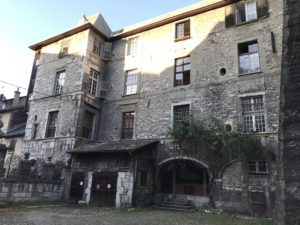In which Sid goes truffling for history in Chambéry.
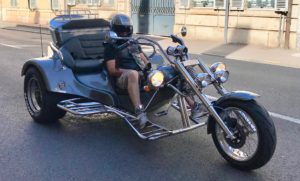 While out doing breakfast-time shopping for lunch, having learned after only 31 years that lunch in France will never be available when you want it, we see an early candidate for conveyance of the day: a trike based on a Beetle floor pan. “S” is rather envious.
While out doing breakfast-time shopping for lunch, having learned after only 31 years that lunch in France will never be available when you want it, we see an early candidate for conveyance of the day: a trike based on a Beetle floor pan. “S” is rather envious.
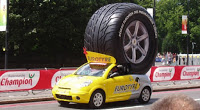
Doris drives. Sid drives. An oddly-shaped car came in the other direction – looking like a mobile Eurotyre logo, it takes a while to realise that it must be Eurotyre’s car for the Tour de France publicity wagon. [I wasn’t quick enough to get a picture so thanks to Mario who published this one – D.] A few miles were whiled away musing over the chances of the rescheduled Tour running this year – it’s now due to start at the end of August but the combination of Covid and crowd control must make it feel unlikely.
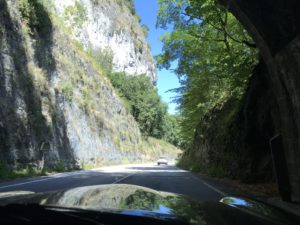
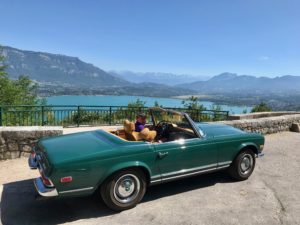 Picnics are eaten and all zooms cheerily along as the scenery becomes more mountainous. The real driving plan is to go over the pre-tunnel Col du Chat route into Chambery, above the Lac du Bourget. There were a few classics about, including a scruffy Alpine 310 in red with the six lamps across the front under perspex. We got used to using Hermann’s melodious horn to greet well wishers. Top hooting for a cream Pagoda met as we were going up the Col du Chat and more excitement as we met a red one on our way down. This is quite a prosperous area.
Picnics are eaten and all zooms cheerily along as the scenery becomes more mountainous. The real driving plan is to go over the pre-tunnel Col du Chat route into Chambery, above the Lac du Bourget. There were a few classics about, including a scruffy Alpine 310 in red with the six lamps across the front under perspex. We got used to using Hermann’s melodious horn to greet well wishers. Top hooting for a cream Pagoda met as we were going up the Col du Chat and more excitement as we met a red one on our way down. This is quite a prosperous area.
Chambéry was the old capital of Savoy, which like much of Europe was contested territory. It stretched from Turin to Bresse, North as far as Geneva and South to Nice. Very fine real estate. To escape from French attacks the Dukes moved their HQ to Turin. In 1792 France took the area west of the Alps and under Napoleon Buonaparte it was part of the Department of Mont Blanc (which we have seen these last couple of days). All change with the defeat of Napoleon in 1815, when the land went back to Turin’s House of Savoy. However in 1860 under Napoleon 3rd, Nice, Chambery and the Alpine bits were back in France.
Italy invaded France in June 1940, then with the agreement of the Vichy regime and the Germans administered the land as far west as Toulon and up the Rhone to Annecy. This exciting act of friendliness beyond town twinning does not merit a panel on the town walk. Germany occupied the area after the Italians switched sides in September 1943.
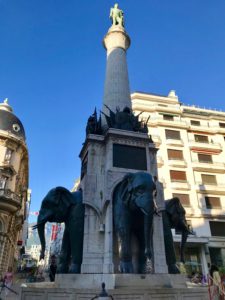 It is a fine place for a pre-dinner walking tour, and the town have helpfully designed one which takes in some interesting little back alleys as well as the usual sights – castle, cathedral, and the best monument is this elephant fountain, raised to thank Benoit de Boigne for spending in the town his ill gotten gains from the French colonies in India. Mr Bat finds it very funny that the local name for the four elephants is ‘les quatres sans culs’ or the four no-bottoms. Tee, hee, heee.
It is a fine place for a pre-dinner walking tour, and the town have helpfully designed one which takes in some interesting little back alleys as well as the usual sights – castle, cathedral, and the best monument is this elephant fountain, raised to thank Benoit de Boigne for spending in the town his ill gotten gains from the French colonies in India. Mr Bat finds it very funny that the local name for the four elephants is ‘les quatres sans culs’ or the four no-bottoms. Tee, hee, heee.
 Chambéry also seems to have more than the average number of shops specialising in board games (including role playing games, dungeons-and-dragons successors etc) and a bit of work with Mr Google turns up the fact that the Savoie Retro Games Festival is held here every year. The description really requires no translation: “Le Savoie Retro Games Festival est un évènement d’envergure autour du retrogaming et de la culture Geek.” We watch in some fascination as a couple sit down next to us at a cafe and rip open their newly-purchased game with trembling hands, speed-reading the rules before finally throwing the first set of dice with a small sigh of satisfaction. The cover of Pandemic Zone Rouge, seen here through a shop window, seems to be spookily prescient.
Chambéry also seems to have more than the average number of shops specialising in board games (including role playing games, dungeons-and-dragons successors etc) and a bit of work with Mr Google turns up the fact that the Savoie Retro Games Festival is held here every year. The description really requires no translation: “Le Savoie Retro Games Festival est un évènement d’envergure autour du retrogaming et de la culture Geek.” We watch in some fascination as a couple sit down next to us at a cafe and rip open their newly-purchased game with trembling hands, speed-reading the rules before finally throwing the first set of dice with a small sigh of satisfaction. The cover of Pandemic Zone Rouge, seen here through a shop window, seems to be spookily prescient.
 If you are in Chambéry for dinner it would be neglectful not to visit Restaurant La Maniguette where they do real cooking and run a charming dining room. No food pictures, as S and D were too busy saying ooh, that is truffly.
If you are in Chambéry for dinner it would be neglectful not to visit Restaurant La Maniguette where they do real cooking and run a charming dining room. No food pictures, as S and D were too busy saying ooh, that is truffly.
[but I have included the menu in case you want to dribble all over your e-reader – D.]
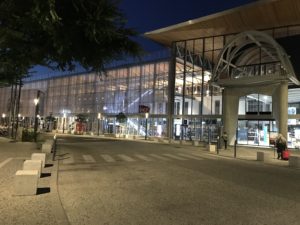 Back to our hotel afterwards which is handy for the very modern-looking station. The French dearly love a project and are still investing heavily in their infrastructure. [We have been reminded of this because our 2013 France map book seems to be lacking some significant new motorways – D.]
Back to our hotel afterwards which is handy for the very modern-looking station. The French dearly love a project and are still investing heavily in their infrastructure. [We have been reminded of this because our 2013 France map book seems to be lacking some significant new motorways – D.]

